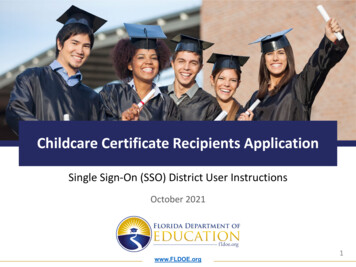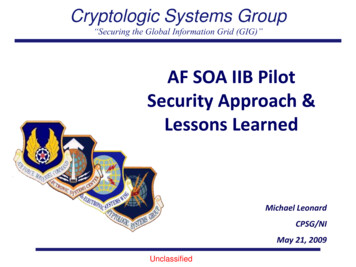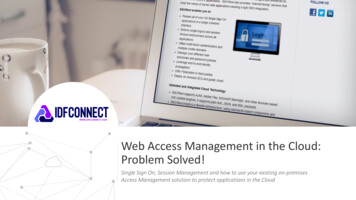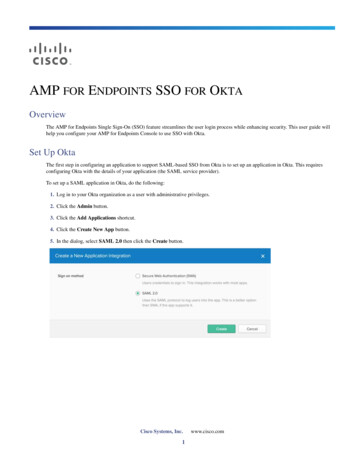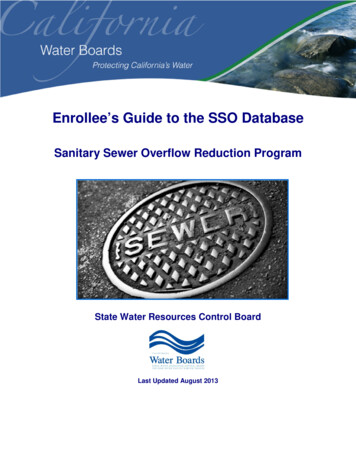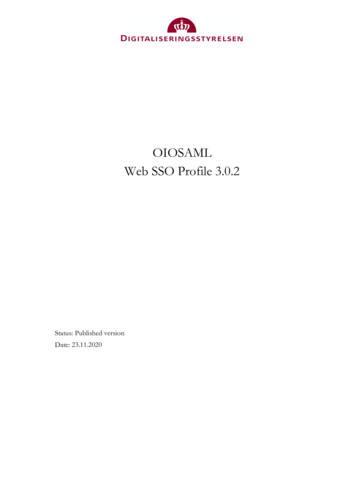
Transcription
OIOSAMLWeb SSO Profile 3.0.2Status: Published versionDate: 23.11.2020
1INTRODUCTION. 51.1 PREFACE . 51.22NOTATION AND TERMINOLOGY . 72.1 REFERENCES TO SAML 2.0 SPECIFICATION . 72.23USAGE SCENARIOS . 6TERMINOLOGY . 7COMMON REQUIREMENTS . 93.1 GENERAL . 93.1.1 Clock Skew .93.1.2 Document Type Definitions .93.1.3 SAML entityIDs .93.2METADATA AND TRUST MANAGEMENT. 103.2.1 Metadata Consumption and Use . 103.2.2 Metadata Production . 103.34CRYPTOGRAPHIC ALGORITHMS . 11SP REQUIREMENTS . 134.1 WEB BROWSER SSO . 134.1.1 Requests . 134.1.2 Responses . 154.1.3 LoA check . 154.1.4 Discovery . 164.2SINGLE LOGOUT . 164.2.1 Requests . 164.2.2 Responses . 174.2.3 Behavioral Requirements . 174.2.4 Logout and Virtual Hosting . 184.3METADATA AND TRUST MANAGEMENT. 184.3.1 Support for Multiple Keys . 184.3.2 Metadata Content . 185IDP REQUIREMENTS . 205.1 WEB BROWSER SSO . 205.1.1 Requests . 205.1.2 Responses . 215.1.3 Issuer . 225.1.4 Subject Identifiers . 225.1.5 Subject Confirmation. 235.1.6 Audience Restriction. 23-2-
5.1.7 Discovery via common domain . 235.2SINGLE LOGOUT . 245.2.1 Requests . 245.2.2 Request Content . 245.2.3 Responses . 245.3ATTRIBUTE QUERY . 255.3.1 Request Message. 255.3.2 Response Message . 265.3.3 Error handling . 265.4METADATA AND TRUST MANAGEMENT. 275.4.1 Support for Multiple Keys . 275.4.2 Metadata Content . 276ATTRIBUTE PROFILES . 286.1 GENERAL REQUIREMENTS. 286.2COMMON ATTRIBUTES . 296.2.1 SpecVer attribute . 296.2.2 BootstrapToken attribute. 296.2.3 Privilege attribute . 296.2.4 Level of Assurance attribute . 306.2.5 Identity Assurance Level attribute . 306.2.6 Authentication Assurance Level attribute . 306.2.7 Fullname attribute . 306.2.8 Firstname attribute . 306.2.9 Lastname attribute. 316.2.10 Alias attribute . 316.2.11 Email attribute . 316.2.12 CPR attribute . 316.2.13 Age attribute. 316.2.14 CPR UUID. 326.2.15 Date of Birth . 326.3NATURAL PERSON PROFILE . 326.3.1 PID attribute (deprecated) . 326.4PROFESSIONAL PERSON PROFILE . 326.4.1 Persistent Identifier attribute . 326.4.2 RID number attribute (deprecated). 336.4.3 CVR number attribute . 33-3-
6.4.4 Organization name attribute. 336.4.5 Production unit attribute. 336.4.6 SE Number attribute . 346.4.7 Authorized to Represent . 347REFERENCES . 35-4-
1 Introduction1.1 PrefaceThis SAML implementation profile (‘OIOSAML Web SSO Profile’) specifies behaviorand options that deployments of the SAML V2.0 Web Browser SSO Profile [SAML2Prof], and related profiles, are required or permitted to rely on. The document is aimed at developers and other technical resources who are involved in developing, configuring and testing implementations and the reader is assumed to beintimately familiar with the core SAML 2.0 specifications.The OIOSAML profile is governed by the Danish Agency for Digitisation and questions about the profile can be sent to: nemlogin@digst.dk. Updates to the profile willbe published at Digitaliser.dk1 where other related resources (including referenceimplementations of the profile) also can be found.Version 3.0 of the profile is to a large degree inspired by the [SAML2Int] profile inorder to leverage the large amount of experience put into this profile, to maximizeinteroperability, allow easier comparison with international profiles and ease implementation.There are several reasons for updating the previous OIOSAML 2.0.9 profile including: The next generation of the Danish eID infrastructure (including MitID andNemLog-in3) will be rolled out in the coming years. This involves substantialchanges to the OCES PKI infrastructure including separation of authentication and signature components.A new reference architecture [REF-ARK] for identity and access managementhas been developed for the public sector.Several new regulations have emerged including GDPR, Danish Dataprotection Act (Databeskyttelsesloven), [eIDAS], [NSIS] etc.There is a need to more clearly highlight formal requirements in the profileand separate them from guidance and explanations.Requirements for algorithms, key lengths, protocols and other security parameters needed to be updated to modern standards.The requirements specified are in addition to all normative requirements of the underlying Web Browser SSO and Single Logout profiles [SAML2Prof], as modified bythe Approved Errata [SAML2Err], and readers are assumed to be familiar with allrelevant reference documents. Any such requirements are not repeated here exceptwhere deemed necessary to highlight a point of discussion or draw attention to anissue addressed in errata but remain implied.1https://www.digitaliser.dk/group/42063-5-
Nothing in this profile should be taken to imply that disclosing personally identifiable information, or indeed any information, is required from an Identity Provider(IdP) with respect to any particular Service Provider (SP). Such privacy considerations remain at the discretion of applicable settings, user consent, or other appropriate means in accordance with regulations and policies. However, this profile doesobligate IdPs to honor certain key signals from an SP in the area of subject identification and requires successful responses to include specific SAML Attributes undercertain conditions.Note that SAML features that are optional, or lack mandatory processing rules, areassumed to be optional and out of scope of this profile if not otherwise precluded orgiven specific processing rules.1.2 Usage ScenariosThis profile is intended for use within Danish public sector federations where information about authenticated identities is communicated across organizations. Thegoal is to achieve standardization, interoperability, security and privacy, while enabling re-use of common implementations. It replaces previous versions of OIOSAML(2.0.9 and earlier). OIOSAML will be the main interface of the public sector IdentityBroker in Denmark (NemLog-in3).It should be noted, that the profile has been designed with flexibility in mind to e.g.allow individual sectors to define their own attribute profiles under OIOSAML. Thus,a delicate trade-off between interoperability and flexibility has been attempted.-6-
2 Notation and terminologyThe key words "MUST", "MUST NOT", "REQUIRED", "SHALL", "SHALL NOT","SHOULD", "SHOULD NOT", "RECOMMENDED", "NOT RECOMMENDED", "MAY", and"OPTIONAL" in this document are to be interpreted as described in BCP 14[RFC2119][RFC8174] when, and only when, they appear in all capitals, as shownhere.This specification uses the following typographical conventions in text: ns:Element , Attribute, Datatype, OtherCode. The normative requirements of thisspecification are individually labeled with a unique identifier in the followingform: [OIO-EXAMPLE-01]. All information within these requirements should beconsidered normative unless it is set in italic type. Italicized text is non-normativeand is intended to provide additional information that may be helpful in implementing the normative requirements.2.1 References to SAML 2.0 specificationWhen referring to elements from the SAML 2.0 core specification [SAML2Core], thefollowing syntax is used: samlp:ProtocolElement - for elements from the SAML 2.0 Protocolnamespace. saml:AssertionElement - for elements from the SAML 2.0 Assertionnamespace.When referring to elements from the SAML 2.0 metadata specification [SAML2Meta],the following syntax is used: md:MetadataElement When referring to elements from the XML-Signature Syntax and Processing Version1.1 WWWC Recommendation [XMLSig], the following syntax is used: ds:Element 2.2 TerminologyThe abbreviations IdP and SP are used below to refer to Identity Providers and Service Providers in the sense of their usage within the SAML Browser SSO Profile andSingle Logout profiles. A proxy-IdP will act in both roles i.e. as a SP towards the ‘real’IdP and as IdP towards the ‘real’ SP.Whether explicit or implicit, all the requirements in this document are meant to apply to deployments of SAML profiles and may involve explicit support for requirements by SAML-implementing software and/or supplemental support via application code. Deployments of a Service Provider may refer to both stand-alone-7-
implementations of SAML, libraries integrated with an application, or any combination of the two. It is difficult to define a clear boundary between a Service Providerand the application/service it represents, and unnecessary to do so for the purposesof this document.-8-
3 Common RequirementsThis chapter includes material of general significance to both IdPs and SPs. Subsequent sections provide guidance specific to those roles.3.1 General3.1.1Clock Skew[OIO-GE-01]Deployments MUST allow between three (3) and five (5) minutes of clockskew — in either direction — when interpreting xsd:dateTime values inassertions and when enforcing security policies based thereupon.The following is a non-exhaustive list of items to which this directive applies: NotBefore, NotOnOrAfter, and validUntil XML attributes found on saml:Conditions , saml:SubjectConfirmationData , samlp:LogoutRequest , md:EntityDescriptor , md:EntitiesDescriptor , md:RoleDescriptor , and md:AffiliationDescriptor elements.3.1.2Document Type Definitions[OIO-GE-02]Deployments MUST NOT produce any SAML protocol message that contains aDocument Type Definition (DTD). Deployments SHOULD reject messagesthat contain them.3.1.3SAML entityIDs[OIO-GE-03]Deployments MUST be named via an absolute URI whose total length MUSTNOT exceed 256 characters. To support having a well-known location fromwhich metadata can be downloaded the Entity Identifier SHOULD be derivedfrom the internet domain name of the Service Provider e.g.https://saml.[domain name]-9-
An entityID SHOULD be chosen in a manner that minimizes the likelihood of it changing for political or technical reasons, including for example a change to a different software implementation or hosting provider.3.2 Metadata and Trust Management3.2.1Metadata Consumption and Use[OIO-MD-01]Deployments MUST provision their behavior in the following areas basedsolely on the consumption of SAML Metadata [SAML2Meta] the processingrules defined by the SAML Metadata Interoperability profile [SAML2MDIOP]: indications of support for Browser SSO and Single Logout profiles selection, determination, and verification of SAML endpoints and bindings determination of the trustworthiness of XML signing keys selection of XML Encryption keysMetadata exchange mechanisms and establishment of trust in metadata are left todeployments to specify.3.2.2Metadata Production[OIO-MD-02]Deployments MUST have the ability to provide SAML metadata capturingtheir requirements and characteristics in the areas identified above in a secure fashion.Metadata SHOULD NOT include content indicating support for profiles or features beyond the bounds of this profile.3.2.2.1 Keys and Certificates[OIO-MD-03]Public keys used for signing and encryption MUST be expressed via X.509certificates included in metadata via md:KeyDescriptor elements.The certificates MUST be FOCES or VOCES certificates (issued under theOCES2 or OCES3 certificate policies)2 or qualified certificates (according tothe eIDAS regulation) issued to a legal person. Certificates MUST NOT be expired or rien om nemid/oces-standarden/oces-certifikatpolitikker/- 10 -
[OIO-MD-04]RSA public keys MUST be at least 2048 bits in length. At least 3072 bits isRECOMMENDED for new deployments.[OIO-MD-05]EC public keys MUST be at least 256 bits in length.[OIO-MD-06]By virtue of the profile’s overall requirements, an IdP’s metadata MUST include at least one signing certificate (that is, an md:KeyDescriptor withno use attribute or one set to signing), and an SP’s metadata MUST includeat least one signing certificate and one encryption certificate (that is,an md:KeyDescriptor with no use attribute or one set to encryption).3.3 Cryptographic Algorithms[OIO-ALG-01]Deployments MUST only use the following algorithms when communicatingwith peers in the context of this profile. Where multiple options exist, any ofthe these may be used, and the chosen algorithm should be agreed upon viametadata or similar. The profile will be updated as necessary to reflectchanges in government and industry recommendations regarding algorithmusage. Digesto http://www.w3.org/2001/04/xmlenc#sha256 g-more#rsasha256 cdsasha256 [RFC4051]Block -cbc bc m m m [XMLEnc]Key Transport- 11 -
ohttp://www.w3.org/2001/04/xmlenc#rsa-oaepmgf1p [XMLEnc]ohttp://www.w3.org/2009/xmlenc11#rsa-oaep [XMLEnc]Note: For block encryption the ‘GCM’ variants are more secure than the ‘CBC’ variants,which are allowed for backwards compatibility. The CBC variants may be deprecated in afuture version of the profile.- 12 -
4 SP Requirements4.1 Web Browser SSO[OIO-SP-01]SPs MUST support the Browser SSO Profile [SAML2Prof], as updated by theApproved Errata [SAML2Err], with behavior, capabilities, and options consistent with the additional constraints specified in this section.4.1.1Requests4.1.1.1 Binding[OIO-SP-02]The HTTP-Redirect binding [SAML2Bind] with deflate encoding MUST beused for the transmission of samlp:AuthnRequest messages.[OIO-SP-03]Requests MUST NOT be issued inside an HTML frame or via any mechanismthat would require the use of third-party cookies by the IdP to establish or recover a session with the User Agent. This will typically imply that requestswill involve a full-frame redirect, in order that the top-level window origin beassociated with the IdP.4.1.1.2 Request Content[OIO-SP-04]The samlp:AuthnRequest message SHOULD omitthe samlp:NameIDPolicy element.[OIO-SP-05]The message SHOULD contain an AssertionConsumerServiceURL attribute and MUST NOT contain an AssertionConsumerServiceIndex attribute (i.e., the desired endpoint MUST be the default, or identified viathe AssertionConsumerServiceURL attribute).The AssertionConsumerServiceURL value, if present, MUST match anendpoint location expressed in the SP’s metadata exactly, without requiringURL canonicalization/normalization.As an example, the SP cannot specify URLs that include a port number(e.g., https://sp.example.com:443/acs) in its requests unless it also includes that portnumber in the URLs specified in its metadata, and vice versa.4.1.1.3 Authentication Contexts[OIO-SP-06]- 13 -
The following saml:AuthnContextClassRef values MAY be used torequest the desired [NSIS] assurance level, and if present, MUST be used withthe Comparison attribute set to ghNote the implicit hierarchy between these levels.Note also that use of the above [NSIS] identifiers for LoA (Level of Assurance)requires that the implementation adheres to NSIS requirements for the givenlevel and has been notified to and accepted by the Danish Agency for Digitisation.Example: saml2p:RequestedAuthnContext Comparison "minimum" saml2:AuthnContextClassRef xmlns:saml2 "urn:oasis:names:tc:SAML:2.0:assertion" ial /saml2:AuthnContextClassRef /saml2p:RequestedAuthnContext [OIO-SP-07]The following saml:AuthnContextClassRef values MAY be used torequest the desired attribute profile (see chapter 6 for attribute ta.gov.dk/eid/ProfessionalNote: the comparison attribute mentioned above in [OIO-SP-06] does not apply to theattribute profile but only the assurance level.4.1.1.4 Signed Requests[OIO-SP-08]Requests MUST be signed by the SP using a private key defined in theirmetadata.Note: Since HTTP Redirect binding with DEFLATE encoding is used, the signature is located in the “Signature” query string described by this binding instead of in the requestXML message.4.1.1.5 Proxy IdPs[OIO-SP-09]- 14 -
If the SP is in fact a proxy IdP acting on behalf of another SP, the service provider SHOULD include a Scoping element in the AuthnRequest containing a RequesterID element stating the Service Provider Identityuniquely. The RequesterID MUST uniquely identify the real service provider.Example: samlp:Scoping samlp:RequesterID https://saml.sundhed.dk /samlp:RequesterID /samlp:Scoping 4.1.2Responses4.1.2.1 Binding[OIO-SP-10]SPs MUST support the HTTP-POST binding for the receipt of samlp:Response messages. Support for other bindings is OPTIONAL.[OIO-SP-11]The endpoint(s) at which an SP supports receipt of samlp:Response messages MUST be protected by TLS 1.2 or higher.4.1.2.2 XML Encryption[OIO-SP-12]SPs MUST support decryption of saml:EncryptedAssertion elements.Support for other encrypted constructs is OPTIONAL.4.1.2.3 Error Handling[OIO-SP-13]SPs MUST gracefully handle error responses containing samlp:StatusCode other than -14]The response to such errors MUST direct users to appropriate support resources offered by the SP.4.1.2.4 Forced Re-Authentication[OIO-SP-15]SPs that include a ForceAuthn attribute of true in their requests SHOULDtest the currency of the AuthnInstant element in the received assertionsto verify the currency of the authentication event.4.1.3LoA check[OIO-SP-16]- 15 -
When consuming SAML Assertions, SPs MUST check the specified [NSIS] levelof assurance regardless of any LoA was set in the request. See section 6.2.4where the attribute is defined.Note: SPs are not guaranteed that the IdP can or will honor the requested assurancelevel set in the AuthnRequest .4.1.4Discovery[OIO-SP-17]SPs SHOULD support the Identity Provider Discovery Profile described in[SAML2Prof] which enables a Service Provider to discover which IdentityProviders a principal is using with the web browser SSO profile.Note: The profile relies on a cookie that is written in a domain common between Identity Providers and Service Providers in a deployment. The cookie contains a list of Identity Provider identifiers and the most recently used IdP should be at the end of the list.4.2 Single Logout[OIO-SP-18]SPs MUST support the Single Logout Profile [SAML2Prof], as updated by theApproved Errata [SAML2Err]. The following requirements apply in the caseof such support.4.2.1Requests4.2.1.1 Binding[OIO-SP-19]The HTTP-Redirect binding [SAML2Bind] MUST be used for the transmissionof (the initial) samlp:LogoutRequest messages to the IdP.[OIO-SP-20]SPs MUST support the HTTP-Redirect or HTTP-POST [SAML2Bind] bindingfor the receipt of samlp:LogoutRequest messages from the IdP, andMAY support SOAP binding.[OIO-SP-21]Requests MUST NOT be issued inside an HTML frame or via any mechanismthat would require the use of third-party cookies by the IdP to establish or recover a session with the User Agent. This will typically imply that requestsmust involve a full-frame redirect, in order that the top level window originbe associated with the IdP.Note: The full-frame requirement is also necessary to ensure that full control of theuser interface is released to the IdP.- 16 -
4.2.1.2 Request Content[OIO-SP-22]Logout Requests MUST be signed.[OIO-SP-23]The saml:NameID element included in samlp:LogoutRequest messages MUST exactly match the corresponding element received from the IdP,including its element content and all XML attributes included therein.[OIO-SP-24]The saml:NameID element in samlp:LogoutRequest messagesMUST NOT be encrypted3.4.2.2Responses4.2.2.1 Binding[OIO-SP-25]The HTTP-Redirect, HTTP-POST or SOAP binding [SAML2Bind] MUST beused for the transmission of samlp:LogoutResponse messages to theIdP.[OIO-SP-26]SPs MUST support the HTTP-Redirect or HTTP-POST binding[SAML2Bind] binding for the receipt of samlp:LogoutResponse messages from the IdP (to the initial request).4.2.2.2 Response Content[OIO-SP-27]Responses MUST be signed.4.2.3Behavioral Requirements[OIO-SP-28]SPs MUST terminate any local session before issuing a samlp:LogoutRequest message to the IdP.Note: This ensures the safest possible result for subjects in the event that logout fails forsome reason.[OIO-SP-29]SPs MUST NOT issue a samlp:LogoutRequest message as the result ofan idle activity timeout.3Due to interoperability concerns.- 17 -
Note: Timeout of a single application/service must not trigger logout of an SSO sessionbecause this imposes a single service’s requirements on an entire IdP deployment. Applications with sensitivity requirements should consider other mechanisms, such asthe ForceAuthn attribute, to achieve their goals.4.2.4Logout and Virtual Hosting[OIO-SP-30]An SP that maintains distinct sessions across multiple virtual hosts SHOULDidentify itself by means of a distinct entityID (with associated metadata) foreach virtual host.Note: A single entity can have only one well-defined SingleLogoutService endpoint per binding. Cookies are typically host-based and logout cannot typically be implemented easily across virtual hosts. Unlike during SSO, a samlp:LogoutRequest message cannot specify a particular response endpoint, so this scenario is generally not viable.4.3 Metadata and Trust Management4.3.1Support for Multiple KeysThe ability to perform seamless key migration depends upon proper support forconsuming and/or leveraging multiple keys at the same time.[OIO-SP-31]SP deployments SHOULD support multiple signing certificates in IdPmetadata and MUST support validation of XML signatures using a key fromany of them.[OIO-SP-32]SP deployments SHOULD be able to support multiple decryption keys andMUST be able to decrypt saml:EncryptedAssertion elements encrypted with any configured key.4.3.2Metadata Content[OIO-SP-33]By virtue of this profile’s requirements, an SP’s metadata MUST contain: an md:SPSSODescriptor role elementoat least one md:AssertionConsumerService endpoint elementoat least one md:KeyDescriptor element whose use attribute isset to encryptionoat least one md:KeyDescriptor element whose use attribute isset to signing- 18 -
ooexactly one md:NameIDFormat element within their md:SPSSODescriptor element containing ransientindicating a fresh/transient identifier per authen
When referring to elements from the SAML 2.0 core specification [SAML2Core], the following syntax is used: samlp:ProtocolElement - for elements from the SAML 2.0 Protocol namespace. saml:AssertionElement - for elements from the SAML 2.0 Assertion namespace. When referring to elements from the SAML 2.0 metadata specification [SAML2Meta],
